Brazilian cruzeiro (1990–1993)
 From Wikipedia - Reading time: 9 min
From Wikipedia - Reading time: 9 min
This article has multiple issues. Please help improve it or discuss these issues on the talk page. (Learn how and when to remove these messages)
|
 A 500 thousand cruzeiros note portraying Mário de Andrade | |
| ISO 4217 | |
|---|---|
| Code | BRE |
| Unit | |
| Plural | cruzeiros |
| Symbol | Cr$ |
| Denominations | |
| Subunit | |
| 1⁄100 | centavo |
| Plural | |
| centavo | centavos |
| Banknotes | 50, 100, 200, 500, 1,000, 5,000, 10,000, 50,000 100,000 and 500,000 cruzeiros |
| Coins | 1, 5, 10, 50, 100, 500, 1,000 and 5,000 cruzeiros |
| Demographics | |
| Date of introduction | 16 March 1990[1] |
| Replaced | Cruzado novo |
| Date of withdrawal | 31 July 1993[2] |
| Replaced by | Cruzeiro real |
| User(s) | Brazil |
| This infobox shows the latest status before this currency was rendered obsolete. | |
The cruzeiro was the currency of Brazil between 1990 and 1993. It was the third iteration of a Brazilian currency named "cruzeiro", and replaced the cruzado novo at par. It was used until 1993, when it was replaced by the cruzeiro real at a rate of 1 cruzeiro real = 1000 cruzeiros.
History
[edit]In late 1989 and early 1990, inflation reached increasingly rampant levels, with monetary deterioration throwing most of the available resources into financial speculation. In an attempt to reduce this, President-elect Fernando Collor contacted President José Sarney, then at the end of his term and by mutual agreement, a bank holiday was announced from March 12 to 15. When President Collor took office, 80% of the amount deposited in the accounts, except for accounts that had a maximum value of 50,000 cruzados novos, had their value confiscated and frozen in the accounts for a period of 18 months, except in exceptional cases. The currency in circulation was renamed to Cruzeiro and due to the economic shock, the economy went into recession at the time. At the time, the old Cruzeiro banknotes (up to 10 centavos of Cruzado Novo) were withdrawn and Cruzado banknotes still in circulation began to be withdrawn and this process continued until the end of 1990. Despite the fact that inflation had reduced in relation to the levels it had in the early 1990s, the Collor Plan was not successful in reducing inflation to reasonable levels, and despite the shocks of the Plano Collor I in 1990 and the subsequent Plano Collor II in 1991, inflation remained high, and political instability made economic stabilization difficult, which was only possible with the advent of the Plano Real in 1994.
Coins
[edit]The 1, 5, 10 and 50 centavo coins issued in 1989 for use with the previous currency continued in use after the introduction of the cruzeiro. In 1990, stainless-steel 1, 5, 10 and 50 cruzeiro coins were introduced, completing the coin family started in 1989. With the exception of the value of 1 cruzeiro, issued only in 1990, the other coins of this family were issued until 1992.
| Reverse | Obverse | Value | Minting period | Obverse description |
|---|---|---|---|---|
 |
 |
Cr$1 | 1990 | Portrays a section of the rhombus from the flag of Brazil |
 |
 |
Cr$5 | 1990–1992 | Portrays a salt evaporation pond worker |
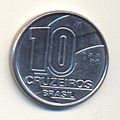 |
 |
Cr$10 | Portrays a rubber tapper and a factory plant | |
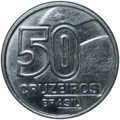 |
 |
Cr$50 | Portrays a woman selling goods in a street market |
In 1992, on the occasion of the Eco 92 in Rio de Janeiro, a new family of coins began to be issued. The coins of 100 and 500 cruzeiros coins were the first to be released, which would be accompanied by the 1000 cruzeiros coin, launched at the end of the same year. These coins were issued until 1993, when the cruzeiro real was launched.
| Reverse | Obverse | Value | Minting period | Obverse description |
|---|---|---|---|---|
 |
 |
Cr$100 | 1992–1993 | Portrays a manatee, and its Portuguese name in the lettering "Peixe-boi" |
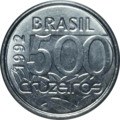 |
 |
Cr$500 | Portrays a sea turtle, and its Portuguese name in the lettering "Tartaruga Marinha" | |
 |
 |
Cr$1000 | Portrays angelfish, and their Portuguese name in the lettering "Acará" |
The cruzeiro only had one circulating commemorative coin, celebrating the 200th anniversary of Tiradentes's death (1792–1992).
Additionally, the cruzeiro also had two distinct non-circulating silver commemorative coins.
| Non-circulating commemorative coins of the Cruzeiro (1990–1993) | ||||
|---|---|---|---|---|
| Reverse | Obverse | Value | Minting period | Description |
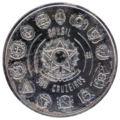 |
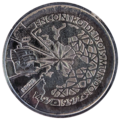 |
Cr$500 | 1991 | Commemorates the 500th anniversary (1492–1992) of the discovery of the Americas by the Europeans |
| (missing photo) | (missing photo) | Cr$2000 | 1992 | Commemorates the UN Conference on Environment and Development, held in Rio de Janeiro in 1992 |
Banknotes
[edit]The first banknotes were overprints on cruzado novo notes, in denominations of 50, 100, 200 and 500 cruzeiros and emergency banknote of 5000 cruzeiros.
-
A NCz$200 note overstamped as Cr$200
In 1990, regular notes in values of 100, 200, 500, 1000 and 5000 cruzeiros were introduced, followed by 10,000 and 50,000 cruzeiros in 1991, 100,000 cruzeiros in 1992 and 500,000 cruzeiros in 1993. In 1992, the 50 and 100 cruzeiro banknotes were withdrawn and the higher denominations were withdrawn in 1994, although banknotes of up to 1000 cruzeiros have been seen very rarely since late 1993.
| Preceded by: Cruzado novo Reason: currency renaming Ratio: at par |
Currency of Brazil 16 March 1990 – 31 July 1993 |
Succeeded by: Cruzeiro real Reason: inflation Ratio: 1 cruzeiro real = 1000 cruzeiros |
References
[edit]- ^ "Medida Provisória Nº 168" (in Brazilian Portuguese). Câmara dos Deputados. 15 March 1990. Retrieved 5 July 2021.
- ^ "Medida Provisória Nº 336" (in Brazilian Portuguese). Casa Civil. 28 July 1993. Retrieved 5 July 2021.
Bibliography
[edit]- "O que foi o Plano Collor" [What the Collor Plan was]. Folha de S.Paulo (in Brazilian Portuguese). São Paulo. 16 March 2005. Retrieved 5 July 2021.
 KSF
KSF

